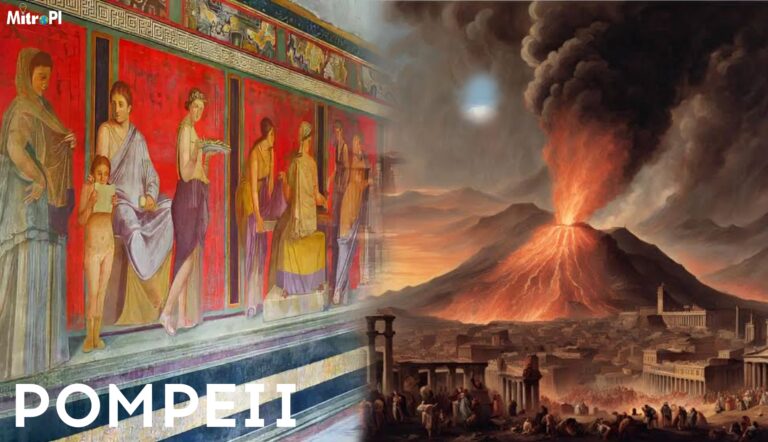In ancient Greece, Sparta was renowned for its military prowess and disciplined lifestyle. However, even the mighty Spartans were not immune to the forces of decline and downfall.

The story of Sparta’s decline is a complex one, influenced by a combination of internal strife, external pressures, and significant historical events. Understanding the factors that led to the fall of Sparta provides valuable insights into the dynamics of power and the fragility of even the most powerful civilizations.
Key Takeaways
- The decline of Sparta was a gradual process.
- Internal conflicts weakened the Spartan state.
- External pressures played a significant role in Sparta’s downfall.
- The fall of Sparta had significant implications for ancient Greece.
- Understanding Sparta’s decline offers insights into the nature of power and civilization.
The Spartan State: Understanding the Warrior Society
Spartan society was a complex entity, characterized by its warrior ethos, a rigid social hierarchy, and a distinctive dual kingship. This unique blend of militarism and governance was the backbone of Sparta’s strength and resilience.
The Unique Social Hierarchy
The social structure of Sparta was highly stratified. At the top were the Spartiates, full citizens who were the descendants of the original inhabitants of Sparta. They held the power and were the warriors of the state. Below them were the Mothakes, who were non-Spartiate free men, often the sons of helots or Spartiates who had been raised together with Spartiate boys. The helots, a serf-like population, were at the bottom, providing agricultural labor.
The Agoge: Creating Spartan Warriors
The Agoge was Sparta’s rigorous education and training program, designed to produce skilled warriors. Boys were enrolled at a young age and underwent a regimen that included physical training, combat skills, and moral education. The goal was to foster discipline, resilience, and loyalty to the state.
Political Structure and the Dual Kingship
Sparta’s political system was unique, featuring a dual kingship where two kings from different families ruled simultaneously. This was balanced by the Gerousia, a council of elders that provided guidance, and the Ephors, elected officials who oversaw the administration and ensured the kings did not abuse their power. This complex system provided checks and balances, contributing to Sparta’s stability.
Sparta’s Golden Age: The Height of Power
After emerging victorious from the Persian Wars, Sparta solidified its position as a dominant force in ancient Greece. This period, often referred to as Sparta’s golden age, was characterized by its military prowess, cultural achievements, and leadership of the Peloponnesian League.
Dominance After the Persian Wars
The Persian Wars marked a significant turning point in Spartan history. Their crucial role in the Battle of Plataea in 479 BCE not only helped to secure a Greek victory but also elevated Sparta’s status among the city-states. As Xenophon noted, “The Spartans were recognized as the leaders of Greece, and their reputation as formidable warriors was cemented.”
“The Spartans were recognized as the leaders of Greece, and their reputation as formidable warriors was cemented.”
Xenophon
The Peloponnesian League
Sparta’s leadership of the Peloponnesian League, a coalition of city-states primarily from the Peloponnese region, further solidified its dominance. The League was formed in the 6th century BCE and played a crucial role in Sparta’s foreign policy, allowing it to exert significant influence over its allies.
| League Member | Contribution |
|---|---|
| Corinth | Naval Power |
| Tegea | Infantry |
| Mantineia | Agricultural Support |
Cultural and Military Reputation
Sparta’s cultural and military reputation reached its zenith during this period. The city-state was renowned for its disciplined warriors, and its cultural achievements, including poetry and music, were highly regarded. As a center of cultural excellence, Sparta attracted visitors from across the Greek world.
The combination of military dominance, cultural achievements, and leadership of the Peloponnesian League defined Sparta’s golden age. This period of unparalleled influence laid the groundwork for the challenges that would eventually lead to its decline.
The Peloponnesian War: Pyrrhic Victory
The clash between Sparta and Athens during the Peloponnesian War reshaped the ancient world. This conflict, which lasted from 431 to 404 BCE, was a defining moment in Greek history, testing the military prowess and strategic flexibility of both city-states.
Conflict with Athens (431-404 BCE)
The Peloponnesian War was a complex and multifaceted conflict, involving not just direct combat between Sparta and Athens, but also a series of alliances, sieges, and naval battles. Sparta’s initial strategy focused on land-based attacks, leveraging their renowned hoplite phalanx formation. However, Athens’s superior naval capabilities and strategic leadership under Pericles allowed it to withstand the early Spartan onslaught.
The Challenges of Naval Warfare
Sparta faced significant challenges in adapting to naval warfare, a domain dominated by Athens. The construction and maintenance of a fleet capable of rivaling the Athenian navy strained Spartan resources. Despite these challenges, Sparta eventually developed a formidable naval presence, crucial for their ultimate victory.
Victory’s Hidden Costs
While Sparta emerged victorious, the cost of the war was staggering. The prolonged conflict had drained Sparta’s resources, strained its social fabric, and led to significant economic and demographic strain. The victory over Athens came at a time when Sparta’s own society was beginning to fray, setting the stage for future challenges.
Spartan Hegemony: The Burden of Empire
With its military prowess unmatched, Sparta expanded its influence beyond Laconia, but at a cost. As the leader of the Peloponnesian League, Sparta’s dominance extended over a significant portion of the Peloponnese, creating a complex network of alliances and obligations.
Ruling Beyond Laconia
Sparta’s expansion beyond its traditional territory marked a significant shift in its role within the Greek world. The city-state transitioned from a regional power to a hegemonic force, exerting influence over various city-states and regions. This expansion was not merely a matter of military conquest but also involved diplomatic efforts to secure alliances and maintain stability.

Growing Resentment Among Greek States
However, Sparta’s growing power and influence were not without challenges. Many Greek city-states began to resent Sparta’s dominance, viewing it as oppressive and tyrannical. The imposition of oligarchies and the presence of Spartan garrisons in key cities fueled discontent, creating an environment ripe for conflict.
The Corinthian War (395-387 BCE)
The Corinthian War was a significant test of Sparta’s hegemony. The conflict, which involved a coalition of city-states including Thebes, Athens, Corinth, and Argos, was sparked by growing dissatisfaction with Spartan rule. Although Sparta emerged victorious, the war highlighted the fragility of its position and the deep-seated resentment among the Greek states.
The burden of empire weighed heavily on Sparta, as maintaining its hegemony required constant military engagement and diplomatic maneuvering. The strain on its resources and the challenges of managing its alliances would eventually contribute to the erosion of its power.
The Battle of Leuctra: The Beginning of the Fall of Sparta
Epaminondas and the Thebans orchestrated a revolutionary victory at Leuctra, forever altering the landscape of ancient warfare. This battle, fought in 371 BCE, marked a significant turning point in the history of ancient Greece, as it challenged the long-standing dominance of Sparta.
Innovative Tactics Under Epaminondas
The Theban general Epaminondas is renowned for his innovative tactics, which played a crucial role in the outcome of the Battle of Leuctra. He employed an unconventional strategy known as the “oblique order,” where he concentrated his forces on the left wing, creating a powerful thrust against the Spartan lines.
The Devastating Defeat of 371 BCE
The Spartans, known for their military prowess, suffered a crushing defeat at Leuctra. The Theban forces, led by Epaminondas, broke through the Spartan phalanx, inflicting heavy casualties. This defeat was not only a military setback but also had significant psychological and social implications for Sparta.
Psychological Impact on Spartan Prestige
The loss at Leuctra severely dented the Spartan reputation for invincibility. It led to a decline in Spartan morale and prestige, both within their own territories and among other Greek city-states. The psychological impact was profound, as it challenged the very identity of the Spartans as superior warriors.
| Aspect | Pre-Leuctra Sparta | Post-Leuctra Sparta |
|---|---|---|
| Military Reputation | Invincible, dominant | Vulnerable, challenged |
| Morale | High, confident | Declining, uncertain |
| Social Impact | Respected, feared | Questioned, diminished |
Loss of Messenia: Economic Catastrophe
The liberation of Messenia from Spartan rule dealt a devastating blow to the Spartan economy. For centuries, Messenia had been a crucial source of agricultural produce, supporting Sparta’s warrior society.
Liberation of the Helots
The helots, who were essentially serfs bound to the land, were a significant part of the Spartan agricultural workforce. Their liberation in Messenia meant that Sparta lost a substantial portion of its labor force.
Agricultural Foundation Destroyed
The loss of Messenia’s agricultural output severely impacted Sparta’s economy, as it had relied heavily on the region’s fertile land and the labor of the helots. This not only reduced Sparta’s food production but also diminished its ability to sustain a large population.
Shrinking Territory and Resources
With the loss of Messenia, Sparta’s territory and resources shrunk significantly. This reduction had a cascading effect on the Spartan economy, limiting its capacity to maintain its military prowess and support its citizens.
| Economic Impact | Pre-Loss of Messenia | Post-Loss of Messenia |
|---|---|---|
| Agricultural Output | High | Significantly Reduced |
| Labor Force | Large Helot Population | Reduced due to Liberation |
| Territory | Larger, including Messenia | Shrunk, excluding Messenia |
The Demographic Crisis: Oliganthropia
The demographic crisis, known as oliganthropia, played a crucial role in the decline of Sparta. Oliganthropia, meaning “too few people,” was a condition that severely affected the Spartan society.
The decline in the number of full Spartan citizens was a significant issue. Several factors contributed to this decline, including a decrease in birth rates among Spartans and the loss of lives in continuous wars.
Declining Spartan Citizen Population
The number of full Spartan citizens, known as Spartiates, dwindled over time. This decline was partly due to the rigorous Spartan education system, known as the Agoge, which was highly demanding and not all young Spartans survived it.
Concentration of Land Ownership
Another factor was the concentration of land ownership. Wealthy Spartans accumulated large tracts of land, leading to a significant number of Spartans losing their properties and, consequently, their citizen status.
The Problem of “Inferiors” (Hypomeiones)
The class of “inferiors” or Hypomeiones emerged as a significant social issue. These were Spartans who had lost their economic status and were no longer considered full citizens, leading to social unrest.
The combination of these factors led to a severe demographic crisis that weakened Sparta’s military and economic foundations.
- Decline in Spartiate population
- Concentration of land ownership
- Emergence of “inferiors”
The demographic crisis was a critical factor in Sparta’s downfall. Understanding oliganthropia provides insight into the complexities of Spartan society and the challenges it faced.
Failed Reforms: Attempts to Restore Sparta
Two Spartan kings, Agis IV and Cleomenes III, implemented revolutionary programs to restore Sparta’s former glory. Their efforts, though ambitious, ultimately ended in failure, culminating in the decisive defeat at Sellasia in 222 BCE.
King Agis IV’s Revolutionary Program
King Agis IV initiated a series of radical reforms aimed at reviving Sparta’s economic and military strength. His program included:
- Cancellation of debts
- Redistribution of land
- Enrollment of new citizens
These measures were designed to address the demographic and economic crises that plagued Sparta. However, Agis IV’s efforts were met with resistance from the wealthy elite, and his reforms were ultimately thwarted.
Cleomenes III and the Last Revival
Cleomenes III continued the reform efforts, building upon Agis IV’s initiatives. He:
- Implemented further land redistribution
- Granted citizenship to helots and perioeci
- Reorganized the Spartan army
Cleomenes III’s reforms showed initial promise, but his reign was cut short by the growing threat of the Macedonians.
The Crushing Defeat at Sellasia (222 BCE)
The final blow to Spartan independence came at the Battle of Sellasia, where Cleomenes III faced off against the Macedonian king Antigonus III Doson. Despite a valiant effort, the Spartans were decisively defeated, marking the end of their autonomy.

The defeat at Sellasia signaled the end of Sparta’s attempts to regain its former glory. The once-mighty city-state was forever changed, its legacy reduced to a shadow of its former self.
External Threats: Macedon and the Achaean League
Sparta’s isolation grew as regional confederacies and powerful empires, such as the Achaean League and Macedon, reshaped the Greek political landscape. The rise of these external forces posed significant challenges to Sparta’s remaining influence.
Philip II and Alexander’s Impact on Greece
The conquests of Philip II and his son Alexander the Great dramatically altered the balance of power in Greece. Macedon’s expansion marginalized Sparta, reducing its political and military significance.
The Rise of Regional Confederacies
The formation of the Achaean League represented a new trend in Greek politics, where city-states banded together for mutual defense. This development further isolated Sparta, as neighboring states began to look towards these confederacies rather than Sparta for leadership.
Sparta’s Isolation in a Changing World
As the Hellenistic period progressed, Sparta found itself increasingly disconnected from the broader Greek world. The table below summarizes the key factors contributing to Sparta’s isolation.
| Factor | Description | Impact on Sparta |
|---|---|---|
| Macedonian Expansion | Conquests by Philip II and Alexander | Reduced Spartan influence |
| Rise of Achaean League | Formation of regional confederacy | Shift in allegiance from Sparta |
| Hellenistic Period | New political landscape | Increased isolation |
In conclusion, the external threats from Macedon and the rise of the Achaean League significantly contributed to Sparta’s downfall by isolating it politically and militarily.
The Final Chapter: Sparta Under Roman Rule
As the last vestiges of independence faded, Sparta succumbed to the might of Roman rule. This transition was not sudden but was the culmination of a series of events that eroded Sparta’s autonomy.
Nabis: The Last Independent Ruler
Nabis, who ruled from 207 to 192 BCE, was the last Spartan king to attempt to preserve independence. His reign was marked by reform and conflict, as he sought to revitalize the Spartan state. However, his efforts were ultimately thwarted by the rising power of Rome.
Roman Intervention and the Achaean War
The Roman intervention in Greek affairs led to the Achaean War, a conflict that further diminished Sparta’s sovereignty. The war concluded with the defeat of the Achaean League, and Sparta, having allied itself with Rome, was temporarily spared the worst of the Roman retribution.
Transformation into a Tourist Attraction
Under Roman rule, Sparta underwent a significant transformation. It became a tourist attraction, with its historical significance and legendary past drawing visitors from across the empire. The once-great warrior state was now a relic of history, its legacy preserved for the entertainment and education of others.
The transition to Roman rule marked the final chapter in Sparta’s history as an independent entity. Its legacy, however, continued to captivate and inspire future generations.
Conclusion: The Legacy of Sparta’s Downfall
The fall of Sparta was a complex process, driven by a combination of internal decay and external pressures. The once-mighty city-state’s decline was hastened by its rigid social structure, costly wars, and demographic crises.
The legacy of Sparta continues to captivate historians and enthusiasts alike, offering valuable insights into the dynamics of power, culture, and societal resilience. Despite its eventual downfall, Sparta’s historical significance remains profound, influencing Western political and military thought for centuries.
Sparta’s story serves as a reminder that even the most powerful civilizations are not immune to the forces of change and decline. As we reflect on the legacy of Sparta, we are reminded of the importance of adaptability, social cohesion, and prudent leadership in ensuring the long-term viability of any society.
FAQ
What were the main factors that led to the downfall of Sparta?
The downfall of Sparta was a result of a combination of internal and external factors, including the Peloponnesian War, demographic crises such as oliganthropia, the loss of Messenia, and external pressures from powers like Macedon and the Achaean League.
How did the Peloponnesian War affect Sparta?
The Peloponnesian War had a significant impact on Sparta, leading to a Pyrrhic victory that strained its resources and society. The war effort required significant financial and human resources, contributing to long-term economic and demographic challenges.
What was the significance of the Battle of Leuctra for Sparta?
The Battle of Leuctra in 371 BCE marked a significant turning point in Spartan history, as it resulted in a devastating defeat at the hands of the Thebans under Epaminondas. This battle not only undermined Spartan military prestige but also led to the liberation of the helots and the loss of Messenia.
What was oliganthropia, and how did it affect Sparta?
Oliganthropia refers to the decline in the number of full Spartan citizens. This demographic crisis was caused by factors such as a declining birth rate, concentration of land ownership, and the emergence of a class of “inferiors” or Hypomeiones, ultimately weakening Sparta’s social and military fabric.
How did the Roman Empire impact Sparta?
Under Roman rule, Sparta underwent significant changes, including its transformation into a tourist attraction. The reign of Nabis, the last independent Spartan ruler, was a notable period before Sparta’s eventual incorporation into the Roman Empire.
What were the attempts made to reform Sparta, and were they successful?
Attempts to reform Sparta were made by rulers such as King Agis IV and Cleomenes III, who introduced revolutionary programs aimed at restoring Sparta’s former glory. However, these efforts ultimately ended in failure, culminating in the defeat at Sellasia in 222 BCE.
How did the loss of Messenia impact Sparta’s economy?
The loss of Messenia was an economic catastrophe for Sparta, as it destroyed the city’s agricultural foundation and significantly reduced its territory and resources. The liberation of the helots further exacerbated the economic strain.




